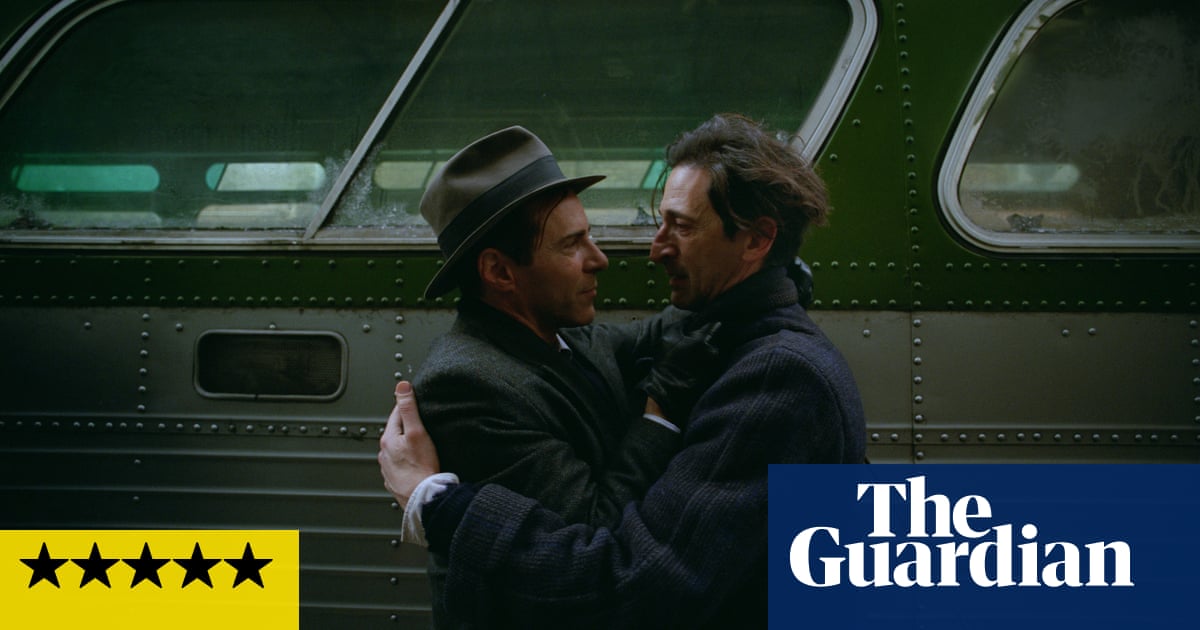Brady Corbet’s amazing and engrossing epic The Brutalist is about the design of postwar America and what was mixed into its foundations at the building stage. It asks us to decide if and how the brutalism of the title applies to something other than architecture, and wonders about the future ruin of what we all imagine at the drawing board of youth: an American Ozymandias.
It is about antisemitism and the capitalist adventure, about the unassimilated immigrant experience and about American can-do naivety v the tragic, painful depths of European culture and expertise.
This is a film with thrilling directness and storytelling force, a movie that fills its widescreen and three-and-a half-hour running time with absolute certainty and ease, as well as glorious amplitude, clarity and even simplicity – and yet also with something darkly mysterious and uncanny to be divined in its handsome shape.
It feels as if it must be based on a real-life case, or at least a literary source – but this is an original screenplay by Corbet and his co-screenwriter Mona Fastvold. It is the biopic of an imaginary Hungarian architect and Holocaust survivor, László Tóth, who comes to the postwar US in poverty but begins, or rather revives, his distinguished career with the impulsive, eccentric patronage of a wealthy man with the Wasp-presidential name of Van Buren. This is a bluff and patrician fellow who has the good taste and imagination to recognise Tóth’s gifts but is finally to demonstrate a dark side in his bigotry, violence and envious shame at his own mediocrity.
Tóth is played with angular fierceness and passion by Adrien Brody: a career best for him, surely, and an advance on his performance in Roman Polanski’s The Pianist. His wife, Erzsébet (Felicity Jones), and orphaned niece Zsófia (Raffey Cassidy) are marooned in Europe, caught in a bureaucratic muddle.
Tóth’s breezily prosperous cousin Attila (Alessandro Nivola) first offers Tóth a job in his Philadelphia furniture store but his American Catholic wife – Attila has converted to Catholicism and anglicised his name – is fatefully to take against Tóth. His only male friend is Gordon (played with dignity and restraint by Isaach de Bankolé), a widower, military veteran and single dad whom Tóth met in the bread line.
And Harrison Van Buren is wonderfully played by Guy Pearce with rich tailoring, face whiskers and a plummy, booming tone born of an addiction to madeira; it may have been inspired by the John Huston voice that Daniel Day-Lewis found to play his tortured oilman in Paul Thomas Anderson’s There Will Be Blood.
From the very first, there is something ominous in the half-starved European artist’s encounter with the plump American plutocrat, perhaps in his encounter with the US itself. When Tóth staggers up from the hold of his immigrant ship to get his first ecstatic look at the Statue of Liberty, he is dazed, woozy, and the statue looms disturbingly upside down (like the upside-down shots in Corbet’s comparable Euro-American parable The Childhood of a Leader).
Tóth gets a job remodelling Van Buren’s library in his palatial estate – although Van Buren knows nothing about it; the job was commissioned as a birthday surprise while he was away by his bumptious and slippery son Harry Van Buren (Joe Alwyn). Tóth is thrilled by the possibilities in the library’s high ceilings and its overhead atrial light-source, forms that appear to inspire his work for the rest of his career, although it is only at the very end that we discover what the actual inspiration is.
Van Buren Sr is initially furious at his idiot son presuming to get these scruffy foreigners to rebuild his library behind his back but then decides he is delighted by the bold modernist reimagining that makes the library look larger than it is. A dinner guest of Van Buren’s says it looks like the endless library in a short story he read once (presumably Borges’s The Library of Babel).
So he offers Tóth a king’s ransom (and also uses his political contacts to get Erzsébet and Zsófia into the US) so that Tóth can mastermind the building of a vast community centre in the town in memory of his late mother – a huge and metastasising folly rather like the Xanadu mansion in Welles’s Citizen Kane. Van Buren, in fact, insists on regaling Tóth with his own Rosebud moment – when he humiliated his impoverished grandparents who had been cruel to his beloved mother but begged him for money once he’d made it big.
But Tóth’s haughty perfectionism, quick temper and his own problems with drink and drugs make the project an ordeal. The Protestant locals are suspicious of Tóth as a Jew and costs overrun from the start despite Tóth telling his patron how cheap concrete is, as opposed to marble. It seems, moreover, that Van Buren’s detested grandparents loved marble, which further disposes Van Buren in favour of concrete. When the pair of them finally visit the spectacular Carrara marble quarries – an extraordinary late sequence – it is another ill omen.
The Brutalist obviously takes something from Ayn Rand, but also from Bernard Malamud and Saul Bellow in its depiction of the US immigrant adventure and the promise of success – but maybe Corbet and Fastvold go further and faster into how dizzyingly sensual and sexual it all is. The film shows us the violence and the savagery – not the same as “brutalism” – that go with capitalist failure and success, with Van Buren Sr (and perhaps junior) guilty of rape.
It is an electrifying piece of work, stunningly shot by cinematographer Lol Crawley and superbly designed by Judy Becker. I emerged from this movie light-headed and euphoric, dizzy with rubbernecking at its monumental vastness.
